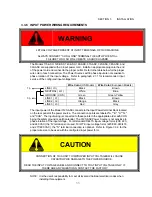
SECTION 3 INSTALLATION
66
3.4.4 TRANSFORMER OUTPUTS - SPECIAL CONSIDERATIONS
OUTPUT
GROUNDING
The output of the ASX-Series Power Source is electrically isolated from the input power and earth
ground. This allows the user to establish a local ground for the output of the Power Source. The
ASX-Series Power Source is designed to withstand voltage potentials of 150 VAC across the
Neutral output terminal and chassis ground.
For safe operation, a ground reference should be established from output to chassis. When using
the direct-coupled outputs, any leg or neutral may be connected to chassis. This is because the
line to neutral voltage cannot exceed 150 VAC. Hence, the voltage stress from neutral to chassis
never exceeds designed limits.
In the case of transformer-coupled outputs, neutral must be connected to chassis gnd (either
locally or remotely). This is due to the fact that line to neutral voltages can be greater than 150
VAC. If a phase voltage (V
a
, V
b
, or V
c
) were connected to chassis, the voltage would exceed the
150 VAC limit specified for the neutral to chassis voltage. Neutral must remain within 150 VAC of
chassis (earth ground) at all times.
LOW FREQUENCY OPERATION
ASX-Series output transformers are designed to operate from 45 to 5,000 Hz. In the case of
steady-state sine wave output, operation at frequencies as low as 30 Hz (125 VAC V
pri
) is possible.
Systems with transformers connected to the output require special attention when designing
transient profiles (applicable to systems w/UPC). It is possible to design transients in which the DC
Component of the periodic waveform is not zero. Attempting to push DC voltage through the
transformer will cause saturation of the device. However, the output transformers are designed to
support a single event, half-cycle dropout at 125 VAC
pri
, 50 Hz without saturating. Continuous
operation with an asymmetrical (DC component
≠
0) will cause saturation.
Operation at lower frequencies may cause saturation of the output transformers. Lower frequency
operation is possible, but only at reduced output voltages.
















































